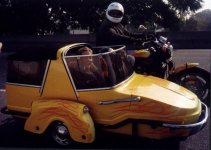Lone Spyder Ryder
New member
[h=1]Motorcycle Throwback - The 1937 Bohmerland[/h]
Ever wish that your motorcycle could fit enough people for your entire carpooling group to fit on so that you don't have to take the car when it's your day to drive? Apparently a Czech engineer by the name of Albin Liebisch had a similar issue. Right before WWII, most families struggled to come up with the money to afford an automobile. Since motorcycles were cheaper, the general populace turned to using motorcycles wit sidecars. But let's face it, the families of the early 1900's were a lot larger than today. Often times, a sidecar wasn't enough of an addition. So Mr. Liebisch attempted to find a way to make motorcycles with a larger passenger capacity.
Under the company name Bohmerland in Germany, Liebisch managed to build motorcycles that had a long enough wheelbase to fit up to three or four riders. The 1937 Bohmerland Langtouren model was a three seater that had to be operated using two gearboxes, one of which was used by the passenger to change gears. This wienerdog of the motorcycle world ran off of a 603cc single cylinger engine with an exposed valve gear. Unlike most motorcycles, it had two gas tanks located on either side of the rear wheel and had a tubular frame. Bohmerland motorcycles were also the first to use cast alloy wheels instead of the typical spoken wheels, which struggled on the harsh country roads and often broke. These motorcycles also had a coil-sprung, leading-link front fork.
Bohmerland claimed that their motorcycles were easier to handle than motorcycles with sidecars. We're slightly skeptical of how well these stretch motorcycles handle during cornering especially since one model had a wheelbase of 10.5 feet. Plus many large families were also seen to have attached side cars to these three seater motorcycles in addition.
Ever wish that your motorcycle could fit enough people for your entire carpooling group to fit on so that you don't have to take the car when it's your day to drive? Apparently a Czech engineer by the name of Albin Liebisch had a similar issue. Right before WWII, most families struggled to come up with the money to afford an automobile. Since motorcycles were cheaper, the general populace turned to using motorcycles wit sidecars. But let's face it, the families of the early 1900's were a lot larger than today. Often times, a sidecar wasn't enough of an addition. So Mr. Liebisch attempted to find a way to make motorcycles with a larger passenger capacity.
Under the company name Bohmerland in Germany, Liebisch managed to build motorcycles that had a long enough wheelbase to fit up to three or four riders. The 1937 Bohmerland Langtouren model was a three seater that had to be operated using two gearboxes, one of which was used by the passenger to change gears. This wienerdog of the motorcycle world ran off of a 603cc single cylinger engine with an exposed valve gear. Unlike most motorcycles, it had two gas tanks located on either side of the rear wheel and had a tubular frame. Bohmerland motorcycles were also the first to use cast alloy wheels instead of the typical spoken wheels, which struggled on the harsh country roads and often broke. These motorcycles also had a coil-sprung, leading-link front fork.
Bohmerland claimed that their motorcycles were easier to handle than motorcycles with sidecars. We're slightly skeptical of how well these stretch motorcycles handle during cornering especially since one model had a wheelbase of 10.5 feet. Plus many large families were also seen to have attached side cars to these three seater motorcycles in addition.
Bohmerland saw it's demise in 1938 when WWII started to tear apart the German economy. Today, it is believed that a mere 30 Bohmerland motorcycles still exist. At an auction at the RAF Museum in Hendon, London on February 27, 2010, one of the remaining 1937 Bomerland Langtouren models was sold for a whopping 36,150 pounds, which is the equivalent of about $58,000 today. Then again, maybe we might just stick with using the car on pooling days.




